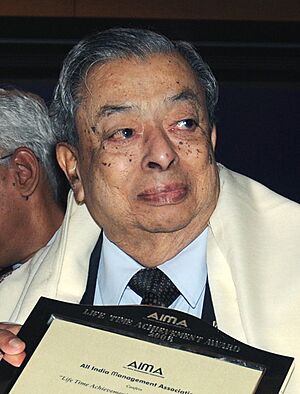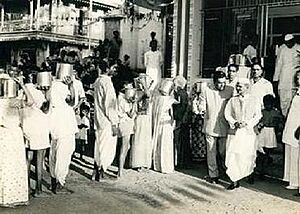Verghese Kurien facts for kids
Quick facts for kids
Verghese Kurien
|
|
|---|---|

Kurien in 2009
|
|
| Born | 26 November 1921 |
| Died | 9 September 2012 (aged 90) Nadiad, Gujarat, India
|
| Nationality | Indian |
| Alma mater |
|
| Occupation | dairy engineer social entrepreneur |
| Employer | Amul |
| Organisation |
|
| Known for | White Revolution in India |
| Awards | Ramon Magsaysay Award (1964) Padma Shri (1965) Padma Bhushan (1966) World Food Prize (1989) Order of Agricultural Merit (1997) Padma Vibhushan (1999) |
Verghese Kurien (born November 26, 1921 – died September 9, 2012) was an amazing Indian engineer. He was also a social entrepreneur, which means he used business ideas to solve social problems. He helped India produce a lot more milk. This huge increase in milk production is known as the White Revolution.
Kurien studied physics at the University of Madras in 1940. Later, he earned a master's degree in mechanical engineering from Michigan State University in 1947. In 1949, the Indian government sent him to a creamery in Anand. There, he helped start a milk cooperative in 1950. This cooperative later became the famous company, Amul.
Amul helped dairy farmers in villages work together. They formed groups called cooperatives. These cooperatives connected farmers directly to people who bought milk. This way, farmers got paid fairly and controlled their own business. This system helped milk production grow a lot. Farmers became the owners of the cooperative.
In 1965, Kurien became the head of the new National Dairy Development Board (NDDB). This group was created to spread the successful Amul idea across India. In 1979, he started a special school in Anand. It was called the Institute of Rural Management. This school trained people to manage milk cooperatives. Kurien helped set up similar cooperatives all over India. This made dairy farming a huge industry. It also created many jobs in villages. India became the world's largest milk producer in 1998. Because of his work, Kurien is called the "Father of the White Revolution" in India. His cooperative idea also helped other farming areas, like making edible oils.
He received many awards for his work. These included the Ramon Magsaysay Award in 1964. He also won the World Food Prize in 1989. In 1999, he got the Padma Vibhushan. This is India's second highest award for citizens. The French Government also gave him an award in 1997. It was called the Order of Agricultural Merit.
Contents
Verghese Kurien's Early Life
Kurien was born on November 26, 1921, in Calicut. This place is now called Kozhikode in Kerala, India. His family was Christian. His father, P. K. Kurien, was a government doctor. Kurien went to school at Diamond Jubilee Higher Secondary School. He studied physics at Loyola College in 1940. Then, he got a degree in mechanical engineering in 1943.
Kurien's father passed away when he was 22. He then moved to Trichur. He wanted to join the army as an engineer. But his mother wanted him to join the Tata Steel Technical Institute. He graduated from there in 1946.
Kurien got a scholarship from the Indian government. He chose to study dairy engineering. He first spent nine months at a research institute in Bangalore. Then, he went to the United States. He earned a master's degree in mechanical engineering in 1948. Kurien later said he studied other engineering fields too. He felt these would be more useful for India. After the US, he went to Australia to learn more about dairying. This knowledge helped him build the Amul dairy later.
Kurien's Career and Achievements
Starting Work in Dairy
In 1949, the Indian government sent Kurien to a creamery in Anand. He was supposed to work there for five years. On weekends, he went to Bombay. There, he helped Tribhuvandas Patel with dairy equipment. Patel had started a cooperative in 1946. This cooperative helped small dairy farmers. Before this, traders often cheated farmers by setting unfair milk prices. These traders worked for a company called Polson. Polson controlled most of the milk collection. Kurien wanted to leave his government job. But Patel convinced him to stay and help the dairy cooperative.
Building Amul's Success
Kurien helped make the Kaira District Cooperative Milk Producers' Union Limited even better. This group later became Amul. Milk was collected directly from farmers in villages. This was done through the cooperatives. Kurien and Patel got support from Sardar Vallabhbhai Patel. He was a powerful leader at the time. He sent Morarji Desai to help organize the farmers. Kurien and Tribhuvandas Patel believed that if everyone in a village worked together for money, they would grow. This would also help reduce conflicts between different groups. The cooperative dairy idea became very popular. Other parts of India started to notice it.
In 1956, Kurien visited Nestle in Switzerland. Nestle was bringing in milk powder and sugar to make condensed milk in India. Kurien asked Nestle to use less imported goods. He wanted them to make condensed milk from local buffalo milk. He also wanted them to hire more Indians. Nestle refused, saying Indians could not handle the technology. When Kurien returned, he increased condensed milk production at Amul. Two years later, India stopped importing condensed milk. H. M. Dalaya, who studied with Kurien, joined him. He found a way to make skimmed milk powder from buffalo milk. Buffalo milk was common in India, while cow milk was scarce. Amul successfully competed against big companies like Nestle and Glaxo.
Then Prime Minister Jawaharlal Nehru also reduced butter imports. Kurien promised to increase Amul's butter production. He kept his promise, and India stopped relying on imported butter. During the Sino-Indian War in 1962, Amul's milk went to the army. This allowed Polson to gain market share. Kurien asked the government to stop Polson's production. Later, Amul also started making cheese from buffalo milk.
Expanding Across India

In 1964, Prime Minister Lal Bahadur Shastri visited Amul. He talked to the dairy farmers. In 1965, Shastri asked Kurien to spread the Amul idea nationwide. This led to the creation of the National Dairy Development Board (NDDB). Kurien agreed to lead it. But he had conditions. He wanted the NDDB to be independent from the government. He also wanted it to be in Anand, close to the farmers. Kurien got help from groups like UNICEF. He used this help to build more cooperatives. He wanted India to produce its own milk.
Kurien used the money to help move good cattle to cities. He also set up milk centers across the country. This helped make milk prices stable in big cities. The Amul model was copied all over Gujarat. In 1973, Kurien brought all these cooperatives together. They formed the Gujarat Co-operative Milk Marketing Federation (GCMMF). They sold their products under the single Amul brand. Other states also started similar groups. In 1979, he started the Institute of Rural Management in Anand. This school trained managers for the milk cooperatives.
Making India Self-Sufficient
In the 1990s, India started to open its economy. Kurien worked hard to keep big international companies from taking over the dairy business. By 1998, India became the world's largest milk producer. It produced about 17% of all milk globally by 2010–11. In 1998, he convinced Prime Minister Atal Bihari Vajpayee to choose Amrita Patel as his replacement at NDDB. He had trained her to keep NDDB independent. Later, he disagreed with her on some policies. He felt that giving marketing to private companies would weaken the cooperatives. He resigned from his position at GCMMF in 2006.
Other Important Work
Kurien also used his cooperative idea for other farm products. These included fruits, vegetables, and cooking oils. In 1979, the leader of the Soviet Union, Alexei Kosygin, visited Anand. He invited Kurien to the Soviet Union. In 1982, Pakistan asked him to help set up dairy cooperatives. He also helped China start a similar program in 1989. Later, he helped Sri Lanka set up dairy cooperatives. He also led a group called Tribhuvandas Foundation. This group helped women and children's health.
Verghese Kurien's Death
Verghese Kurien passed away on September 9, 2012. He was 90 years old. He died from an illness in Nadiad, near Anand. He had a wife named Molly and a daughter named Nirmala. Kurien was raised Christian but later became an atheist.
Awards and Honors
| Year | Award or Honor | Awarding Organization |
|---|---|---|
| 1963 | Ramon Magsaysay Award | Ramon Magsaysay Award Foundation |
| 1965 | Padma Shri | Government of India |
| 1966 | Padma Bhushan | Government of India |
| 1986 | Krishi Ratna | Government of India |
| 1986 | Wateler Peace Prize | Carnegie Foundation |
| 1989 | World Food Prize | World Food Prize Foundation |
| 1993 | International Person of the Year | World Dairy Expo |
| 1997 | Order of Agricultural Merit | Ministry of Agriculture, France |
| 1999 | Padma Vibhushan | Government of India |
| 2000 | Regional Award | Asian Productivity Organization |
Kurien received many honorary degrees. These are special titles from universities. He got them from places like Michigan State University. He also led or was part of many public groups. He was also given the Godfrey Phillips Bravery Award.
Books by Verghese Kurien
- Kurien, Verghese (2005) I Too Had a Dream.
- Kurien, Verghese (1997) An Unfinished Dream.
- Kurien, Verghese (2012) The Man Who Made The Elephant Dance


